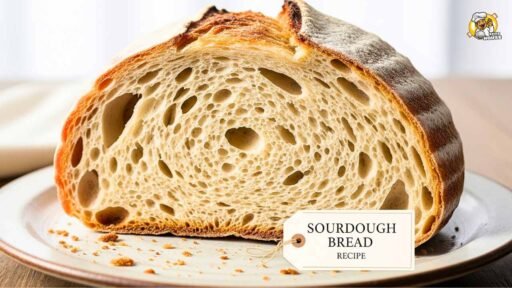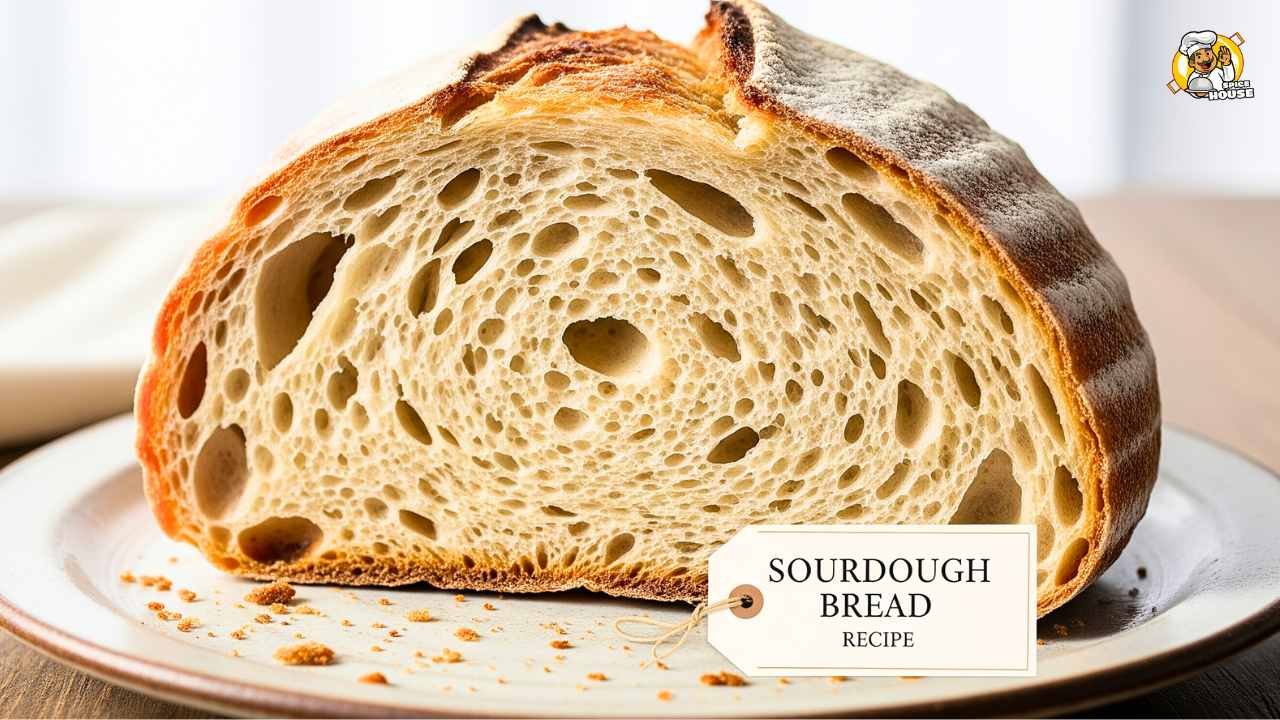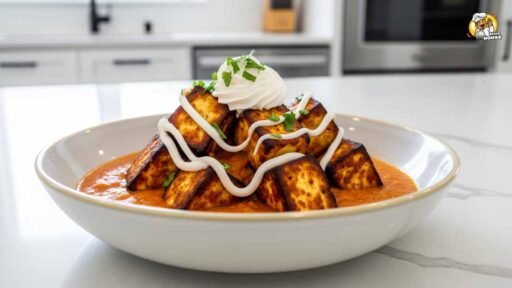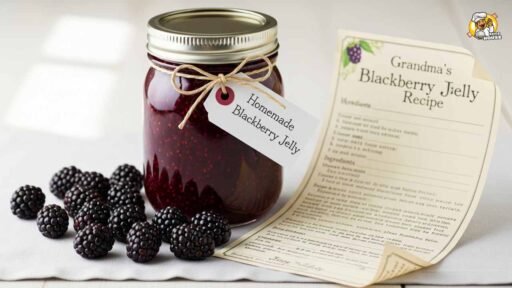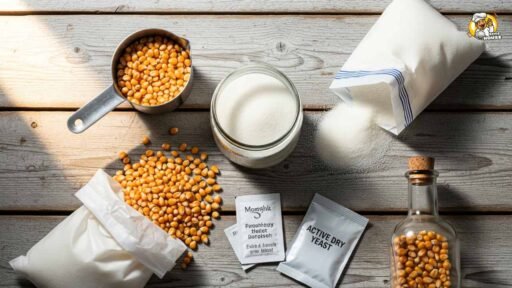U.S. retail flour sales jumped more than 150% in March 2020, according to Nielsen tracking, and the sourdough wave never fully receded. Google Trends still shows U.S. interest in “sourdough” hovering around 40% of its pandemic-era peak in 2025. That’s not a blip; it’s a reset. Now, the most common question in home-baking forums is deceptively simple: Can you double a sourdough bread recipe and expect the same results?
Here’s the thing: Doubling a dough isn’t just multiplication. It changes fermentation speed, dough temperature, and load on your gear. And it’s provoking a very practical debate across the kitchen economy. King Arthur Baking instructors, stand mixer brands like KitchenAid, and even boutique mills all sit in the blast radius of home bakers’ scaling ambitions. The upside is clear: batch efficiency, lower cost per loaf, and better use of a hot oven. The risk reads like a baker’s bingo card: overproofing, gummy crumb, torn gluten, and smoking mixers. Investors track durable trends in cookware and appliances. Consumers want certainty and fewer failures. Employees at flour mills and cookware brands watch demand shift with each well-timed Instagram crumb shot. Isn’t it wild that a simple question—can you double a sourdough recipe?—now touches product design and purchasing behavior?
The Data:
-
According to Nielsen retail scans, flour sales surged more than 150% year over year during March 2020. While volumes normalized, category interest stayed elevated as sourdough home-baking communities persisted into 2025.
-
Google Trends indicates U.S. searches for “sourdough” remain at roughly 40% of the 2020 peak as of mid-2025. In other words, sourdough didn’t vanish; it matured.
-
Modernist Bread and classic fermentation research describe a Q10-style effect: fermentation speed roughly doubles for every 10°C (18°F) rise in dough temperature. Larger dough masses warm faster and hold heat longer, which accelerates fermentation unless you adjust.
-
KitchenAid’s published capacities vary by model, but 5-quart tilt-head mixers top out around 900 g of all-purpose flour in lower-hydration doughs. High-hydration sourdoughs load motors harder, and sources say overfilling leads to premature wear. This smells like a mismatch between marketing and real-world use.
Can You Double a Sourdough Bread Recipe: Step-By-Step Guides
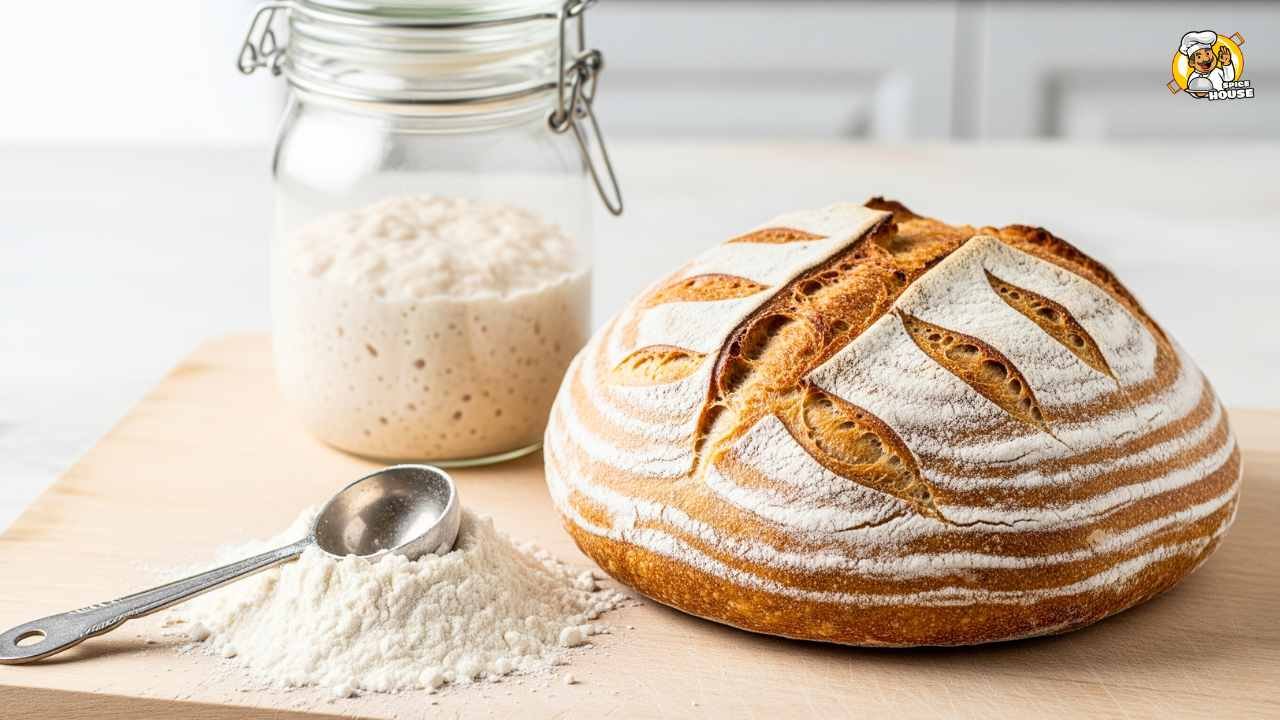
1. Decide if You Should Double and Do the Baker’s Math First
Start with a clear base formula in baker’s percentages. That’s your map. A common lean sourdough might look like this:
- Total flour: 100% (for example, 450 g bread flour + 50 g whole wheat = 500 g)
- Water: 75% (375 g)
- Salt: 2% (10 g)
- Liquid levain at 100% hydration: 20% of flour weight (100 g levain contains 50 g flour + 50 g water, giving ~10% pre-fermented flour)
Now ask: What do you want to double? Loaf size or loaf count? Most home bakers want two standard boules or bâtards, not one monster. If your base dough yields one 750–900 g loaf, doubling yields two of the same. Keep percentages constant to maintain dough feel. Multiply each ingredient by 2, then reconcile levain’s flour and water in your totals. Your revised totals might be:
-
Flour: 1000 g (or keep the 90/10 bread-to-whole-wheat split)
-
Water: 750 g
-
Salt: 20 g
-
Levain (100% hydration): 200 g
If your kitchen runs warm, reduce levain by 10–20% relative to flour for doubled batches to avoid overproofing. If your base formula is already fast (e.g., ≥20% pre-fermented flour and 78% hydration), hold the inoculation steady or even drop to 16–18% levain. You’ll regain control of bulk fermentation. One more sanity check: consider your fridge capacity for cold retard. Two bannetons take up more space than one. If you must stack, plan to invert a sheet pan over the top banneton to prevent drafts.
2. Plan Your Capacity: Bowls, Mixers, Bannetons, and Oven Timing
Scaling is logistics. The dough won’t care about your optimism. It will go where gravity sends it.
-
Containers: Use a clear, straight-sided tub for bulk. Two kilograms of dough expands fast. A 6–8 quart food-safe container gives room for growth and folds. Mark the start level with tape to track volume increase.
-
Tools: A bench knife for division, a bowl scraper for mixing, and a digital scale that handles at least 5 kg total weight. You’ll also want an instant-read thermometer for dough temperature.
-
Mixers: A 5-quart tilt-head KitchenAid can struggle with high-hydration doughs above ~1.2–1.4 kg total. You can hand-mix or split the batch. Professional bowl-lift models handle more, but still watch motor strain. Don’t chase speed. Low gear, short bursts, and rest periods protect both gluten and gears.
-
Bannetons: Two 8–9-inch round bannetons or two oval forms. Flour them generously with a 50/50 mix of rice flour and bread flour to limit sticking.
-
Oven and steam: Two Dutch ovens let you bake both loaves at once. If you have one, bake sequentially and hold the second loaf cold to slow proofing. A baking stone or steel plus a steam pan also works. Preheat longer than you think—at least 45–60 minutes at 500°F (260°C)—to saturate thermal mass.
-
Fridge space: Two bannetons at 9 inches each eat shelf space. Clear a rack and chill your fridge to its colder setting if you plan an overnight retard. Cold dough holds shape and scores cleanly.
Look, the bottleneck is usually heat. The oven door opens, and temperature plummets. Manage your flow: load fast, steam fast, close fast. If you bake one at a time, keep the second dough colder. Your future self will thank you.
3. Mix and Manage Dough Temperature at Scale
Doubled doughs behave warmer. More mass, more friction, more retained heat. Aim for a final dough temperature (FDT) in the 24–26°C range (75–79°F). If your kitchen sits above 24°C (75°F), use cooler water. If it’s chilly, use warmer water. Use a simple FDT formula: Water temp ≈ (desired FDT × 3) − flour temp − room temp − friction factor. For hand mixing, use a friction factor around 2–3°C (4–6°F). Mixer friction can add more heat—watch the thermometer.
Practical mixing flow:
-
Autolyse: Combine flour and 90–95% of the water. Rest 20–40 minutes. This builds extensibility without overworking gluten. Hold back 5–10% water to add with the salt and levain.
-
Levain and salt: Spread levain over the dough, sprinkle salt, and add a splash of the reserved water to help integration. Pinch and fold until homogeneous.
-
Strength building: Perform 100–150 gentle Rubaud strokes or 2–3 minutes of slap-and-folds until the dough smooths. With double batches, stop earlier than you think. You’ll add strength in bulk with coil folds.
-
Rest discipline: Let the dough relax for 15 minutes between efforts. Over-mixing creates tight gluten that resists gas expansion. Undermixing creates uneven crumb. The sweet spot is a dough that stretches without tearing and still feels a bit tacky.
-
Hydration control: If your flour isn’t thirsty, a doubled batch can feel slacker due to heat and enzyme activity. Don’t be shy about holding back 10–20 g of water per 1000 g flour. Add later if the dough asks for it.
You’ll notice this: Larger dough seems to “wake up” faster after mixing. That’s heat and mass talking. Don’t fight physics. Use it.
4. Run Bulk Fermentation Like a Pro: Watch Volume, Not the Clock
Scaling time is the trap. You don’t double time. You double attention.
Cues for the end of bulk remain the same: a 30–50% rise, bubbles along the tub’s edges, a jiggly mass that domes slightly, and a dough that releases from the sides on a gentle shake. Depending on kitchen temperature and inoculation, bulk for doubled dough may run 3–5 hours at 24–25°C (75–77°F). Warmer rooms go faster. Cooler rooms slow down. With a high inoculation, bulk can sprint.
Folding schedule:
-
0:30 after mixing: Coil fold in the tub. Lift gently from the middle and tuck under four times, rotating the container.
-
1:00: Repeat coil fold.
-
1:45: Third coil fold if the dough still feels slack. Skip it if the dough already holds shape and surface tension.
-
2:30+: Let the dough rise undisturbed. A final gentle fold at 3:00 can even out temperature in the dough mass.
If your dough runs hot, move the tub to a cooler spot or onto a marble slab to wick heat. Conversely, if fermentation lags, give the dough a warm water bath by resting the tub over a larger bowl of warm water. You’ll nudge temperature without manhandling gluten.
Slightly skeptical note: Many marketing guides promise “set-and-forget” sourdough. That’s not how biology behaves. Modernist Bread’s Q10 principle tells you why. A small temperature drift yields a big fermentation jump. In doubled batches, that drift often comes from friction and mass. Manage it, and you win.
5. Divide, Shape, Proof, and Bake Without Chaos
Once bulk hits your target, you’re on the clock. Dust your bench lightly. Turn out the dough. Divide it in two equal pieces (use the scale). Pre-shape each into a loose round. Rest 15–20 minutes, uncovered, to relax the gluten.
Final shaping:
-
For boules: Flip the round, tighten by dragging the dough toward you with a bench knife and the heel of your hand. Build tension without tearing the surface.
-
For bâtards: Preform a rectangle, fold top third down, bottom third up, and roll tightly. Seal the seam.
Proof:
-
Banneton preparation: Heavily flour with rice flour blend. Place the seam side up for later seam-down baking.
-
Room-temp proof: 45–90 minutes at 22–24°C (72–75°F). Press test: A gentle poke should spring back slowly and leave a faint indentation.
-
Cold retard: 8–16 hours at 3–5°C (37–41°F). Colder, longer, and more predictable. This is where two loaves shine. You can stagger bakes and keep dough firm for scoring.
Baking:
-
Preheat: 500°F (260°C) with Dutch ovens inside or with a stone/steel and a steam tray. Preheat a full hour for thermal stability.
-
Load and steam: For Dutch ovens, transfer dough seam-down, score the top ¼ inch to ½ inch deep, cover, and reduce oven to 475°F (245°C). Bake 20–25 minutes covered, then 18–25 minutes uncovered until deep brown. If baking on a stone, create steam with a preheated pan and boiling water or lava rocks. Vent steam after 20 minutes.
-
Internal temperature: 205–210°F (96–99°C). Crust should sing, and loaf should feel lighter than it looks.
-
Staggering: If you own one Dutch oven, bake the first loaf while the second rests cold. Rotate positions on the rack halfway through uncovered baking for even color if your oven runs hot on one side.
Expect slightly longer bake times for doubled runs, because you’re cycling heat out of the oven twice. Add 5–10 minutes total per loaf as needed for color and structure. Don’t rush this phase. Underbaking gives you a gummy crumb and a false “done” smell.
6. Troubleshoot the Doubled Batch: Fix Today, Bake Better Tomorrow
Most issues at double scale come from heat and timing. Diagnose fast:
-
Dense or gummy crumb: You likely underbaked or cut too soon. Extend bake by 5–10 minutes uncovered; verify internal temp and let the loaf cool at least 90 minutes before slicing. Next time, reduce levain to 16–18% and lengthen bulk slightly for better gas retention.
-
Overproofed, flat loaves: Reduce room-temp proof time or go straight to cold retard after shaping. Chill the dough to slow fermentation while you preheat.
-
Torn surface or blowouts: Insufficient scoring depth or uneven surface tension. Score ¼–½ inch deep, add a second auxiliary score if the loaf is tight, and ensure a strong final shape.
-
Slack dough that won’t hold shape: Lower hydration by 1–2% for the doubled batch, or add an extra fold early in bulk. Warm kitchens and larger mass can make the dough feel wetter.
-
Mixer strain and dough warming: Hand-mix, split the batch, or rest the mixer between short bursts. Use cooler water to hit your target FDT.
Small wins compound. Nail dough temperature and your schedule, and the double batch starts to feel easier than a single loaf because your oven’s hot once and your hands stay in rhythm.
The People
“A lot of home bakers think scaling means doubling ingredients and doubling time. It doesn’t,” a senior King Arthur Baking instructor told me. “When you scale a dough, you don’t scale time. You scale monitoring.” That mindset shift separates consistent results from the “mystery loaf” experience. The instructor added, “If you’re going from one to two loaves, start by keeping the levain percentage the same. Once you go 3x or more, cut inoculation by 10–20% and protect dough temperature. Fermentation is the first thing that stops scaling linearly.”
On the equipment side, a KitchenAid product manager acknowledged the limits of motors and bowls. “We rate mixers for specific flour capacities, but hydration and dough stiffness matter more than people realize,” the manager said. “High-hydration sourdoughs tax small motors. For double batches, use lower speed, shorter mix windows, or hand techniques. We’re working on clearer guidance.” Sources say future stand mixer materials will tout torque and duty cycle more than wattage. That would be a welcome change for bakers who’ve ever smelled a warm motor mid-bulk.
Independent micro-bakers see opportunity in the “double batch” mindset. “Two loaves baked back-to-back build muscle memory and reduce waste,” a cottage baker in Portland told us. “My unit cost drops, my crumb consistency goes up, and I schedule my retards to keep the oven fed. It’s like mise en place for fermentation.” The pros don’t promise perfection. They promise process. And—honestly—that’s more valuable.
The Fallout
What happens when home bakers double their sourdough recipes at scale and succeed? A few ripples turn into waves.
-
Equipment demand shifts upward: As more bakers hit the ceiling on 5-quart mixers and single Dutch ovens, expect incremental migration to bowl-lift mixers, second Dutch ovens, and bigger stones or steels. Analysts now predict replacement cycles shorten as users learn the hard way that wattage isn’t torque.
-
Energy and cost efficiency improves: Baking two loaves in one preheat cuts per-loaf energy cost and time. Home bakers report 15–30% lower unit cost, depending on electricity rates and ingredient sourcing.
-
Flour and specialty grain sales stabilize: Double-batch routines drive steady pull-through for bread flours, whole grains, and rice flour for bannetons. Boutique mills benefit from repeatable schedules. This isn’t hype; it’s habit formation.
-
Fewer failures reduce churn: When bakers learn that “keep percentages constant, adjust temperature and timing” is the rule, they waste less flour and return fewer defective goods. Customer service teams at appliance brands quietly cheer that trend.
-
A new content niche emerges: We’ll see clearer manufacturer specs keyed to hydration and dough mass. Expect labels like “Hydration Guide: up to 72% at 1.6 kg dough” instead of vague flour-cup counts. If KitchenAid or challengers move first, they set the standard.
There’s a flip side. If brands oversell capacity and under-explain fermentation, trust erodes. Consumers are savvy after five years of collective home-baking education. They compare notes. They notice when corporations spin. They also vote with wallets. We’ve seen this movie in espresso machines and air fryers. Overpromise, then watch returns mount. Underpromise, deliver clarity, and you win sticky customers who keep upgrading within your ecosystem.
Closing Thought
Doubling a sourdough recipe isn’t radical. It’s responsible, if you manage heat, inoculation, and oven flow. But here’s the real question: Will KitchenAid, Le Creuset, and King Arthur Baking codify a hydration-and-mass rating system that demystifies doubled batches, or will home bakers keep crowdsourcing the playbook until a challenger brand seizes the moment? If the latter happens, don’t be shocked when a “hydration rating” becomes the new horsepower and resets the baking aisle.

